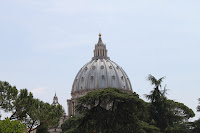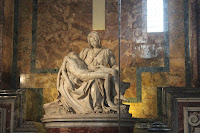





We realize that up to now we have been taking in Europe in small bites, albeit very good small bites. Then we came to Rome and our small bites became an all-you-can-eat buffet. In every direction you look, Rome overwhelms you with its almost 3,000 years of history. Ancient ruins, narrow streets, fountains, monuments, churches, medieval and renaissance houses and hotels are in all directions. Here are some highlights:
Spanish Steps. We started our site seeing at the Spanish Steps, one of the many gathering places for tourists. We felt a bit like we were on our class trip, because all around us we saw American teenagers with their backpacks taking pictures and otherwise acting like teenagers (well behaved teenagers). Other than the persistence of the vendors trying to sell their roses, the Spanish steps are a great first place to see with spectacular views, lots of energy and overall fun. Almost at the foot of the steps is a fountain, the first of so many we would encounter in Rome—clearly something Raleigh needs to add on Fayetteville Street.
John Keats House. At the bottom of the Spanish Steps is a house one occupied by that famous Roman, John Keats. Actually the English Romantic poet Keats lived in this house a few months before he died there from tuberculosis in 1827. In the early 20th century it was purchased and converted to a museum/memorial for him and Percy Blyss Shelly, who had some connection to Keats. In the Keats house, one can see the room where Keats died, furnished as it would have been furnished. This stop was a somewhat quirky interlude from the grandeur of the Spanish Steps and the energy of the street just outside the house. Add to the very long list of things I learned on this trip—Mary Shelly, who wrote Frankenstein, was the wife of Percy Shelly. Hiller had seen the movie, Bright Star, a few years ago, which was based on Keat's life. The docent said that the movie was tightly based on the historical records.
Trevi Fountain and the Pantheon. We next found our way to the Trevi Fountain. It was designed by Nicola Salvi and completed in 1762. The 1954 film, Three Coins in a Fountain, brought renewed interest in this spot. The Pantheon, which means “All the Gods,” was built in 31 B.C. by Augustus Ceasar. We were amazed at the structure, which is considered one of the architectural wonders of the world because of its dome and concept of space.
The Vatican. The Vatican, in a word, was overwhelming! It is 1500 years of what has been the best of western culture. We could have spent a day at the Sistine Chapel (1508-1512) viewing the artistry of Michelangelo. It’s difficult to imagine the physical demands of painting the fresco on a tremendously high scaffold while lying down, but that’s what Michelangelo did. The dome at St. Peter’s Basilica, also designed by Michelangelo, was based on the design of the Pantheon dome. The church is designed to be overpowering, with its statues, frescos, sculptures, ornate artistic detail. St. Peter is recognized at the founder of the Catholic Church and is revered on every turn throughout the Basilica. We had a guide, named Franscesca, who took us on a 3-hour tour of the Vatican and pointed out the political, religious, and artistic high spots of this amazing collection of historical artifacts. Remarkable!
The Colosseum. Today we braved the crowds to get a glimpse of the magnificent Colosseum, which was built around 79 AD. We learned that it was abandoned for over 1000 years, with people removing marble and metals to use in construction of other structures. Today, it is the biggest tourist attraction in Rome, if not in Europe. We imagined the gladiators engaged in fierce matches, with the Emperor and thousands of citizens cheering them on. One guide told us that it was not unusual for the Romans to bring in exotic animals from Africa (lions and elephants) and have them fight—all for entertainment purposes.

These are some of the same sites we visited many years ago. They have not changed. Am enjoying your pics and the commentary of Gabriel. Grandpa
ReplyDeleteyour words brought back many memories. Glad you got to see the chapel. I know this all means so much.
ReplyDeleteAll so very interesting! Gabe - Love your video. You may have a future as a TV reporter.
ReplyDeleteHi Dad, Mom, and Melinda,
ReplyDeleteThanks for commenting.We're in Tuscany now. It is so beautiful! However, the afternoon weather is being a bit uncooperative--rain. We went to the town of Cortona--this is the setting for the movie Under the Tuscan Sun.
Love,
Tom
There is a small replica of the Colosseum in Plovdiv, Bulgaria that was unearthed when the city of Plovdiv was built. Builders were surprised to see the Roman influence in modern-day Bulgaria and have erected a statue to King Philip in honor of Rome.
ReplyDeleteAm loving your posts, pics, and videos!!!
Glad you're in enjoying our posts. Thanks for reading and commenting! Hiller
ReplyDelete